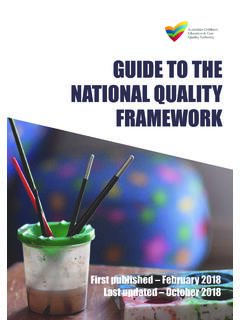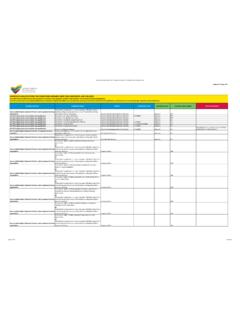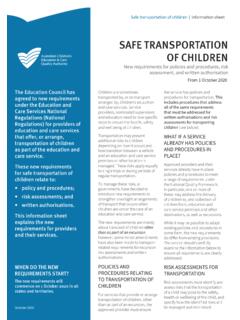Transcription of National Quality Framework - ACECQA
1 1. INTRODUCTION 8 Guide to the NQF | IntroductionGuide to the NQF | IntroductionINTRODUCTION Purpose of guide This guide aims to support education and care service providers, authorised officers and other regulatory authority staff understand the requirements under the National Quality Framework (NQF). The guide should always be read with the Education and Care Services National Law ( National Law) and the Education and Care Services National Regulations ( National Regulations). It is not legal advice, and the National Law and Regulations take precedence over any material in this guide. The guide is regularly reviewed and updated by the Australian Children s Education and Care Quality Authority ( ACECQA ) in consultation with regulatory authorities and the Australian Government. Updates are published on the ACECQA website at This guide sometimes suggests other sources of information which readers may find useful. The National Quality Framework The NQF was the result of an agreement between all Australian governments to work together to provide better educational and developmental outcomes for NQF introduced a new Quality standard in 2012 to improve education and care across long day care, family day care, preschool/kindergarten and outside school hours care services.
2 The NQF aims to raise Quality and drive continuous improvement and consistency in children s education and care services through: the National Law and National Regulations the National Quality Standard an assessment and Quality rating process National approved learning frameworks a regulatory authority in each state and territory responsible for the approval, monitoring and Quality assessment of services in their state or territory a National body ACECQA , which guides the implementation of the NQF and works with regulatory delivery of the NQF is guided by set objectives and guidelines to ensure consistent and effective to the NQF | IntroductionGuide to the NQF | IntroductionThe objectives of the NQF are to: ensure the safety, health and wellbeing of children attending education and care services improve the educational and developmental outcomes for children attending education and care services promote continuous improvement in the provision of Quality education and care services establish a system of National integration and shared responsibility between participating jurisdictions and the Commonwealth in the administration of the National Quality Framework improve public knowledge, and access to information.
3 About the Quality of education and care services reduce the regulatory and administrative burden for education and care services by enabling information to be shared between participating jurisdictions and the National Quality FrameworkNational Quality StandardAssessment and rating process by the regulatory authorityEducation and Care Services National RegulationsEducation and Care Services National LawExcellent (awarded by ACECQA )Exceeding National Quality StandardMeeting National Quality StandardWorking Towards National Quality StandardSignificant Improvement RequiredQA1 Educational program and practiceQA2 Children s health and safetyQA3 Physical environmentQA4 Staffing arrangementsQA5 Relationships with childrenQA6 Collaborative partnerships with families and communitiesQA7 Governance and leadershipApproved Learning FrameworksBELONGING, BEING & BECOMING The Early Years Learning Framework for Australia 1 BELONGING, BEING & BECOMING THE EARLY YEARS LEARNING Framework FOR AUSTRALIA 1 Framework for School Age Care My Time, Our Place Framework FOR SCHOOL AGE CARE IN AUSTRALIA 10 Guide to the NQF | IntroductionGuide to the NQF | IntroductionThe guiding principles of the NQF are as follows.
4 THE RIGHTS AND BEST INTERESTS OF THE CHILD ARE PARAMOUNTThe NQF aligns with the United Nations Convention of the Rights of the Child. This treaty ensures that children have the right to be heard, to be free from violence, abuse and neglect, to have the opportunity to thrive, to be engaged in civics and citizenship and opportunities to take action and be accountable. A rights-based approach to delivering education and care means understanding these rights and implementing practice which reflects them. CHILDREN ARE SUCCESSFUL, COMPETENT AND CAPABLE LEARNERSThe NQF views children as capable learners who actively construct their own understandings and contribute to others learning. It recognises children s agency, capacity to initiate and lead learning, and their rights to participate in decisions that affect them, including their learning. Viewing children as active participants and decision makers opens up possibilities for educators to move beyond pre-conceived expectations about what children can achieve.
5 This requires educators to respect and work with each child s unique qualities and , INCLUSION AND DIVERSITY UNDERPIN THE FRAMEWORKThe NQF recognises all children s capacity and right to succeed regardless of diverse circumstances, cultural background and abilities. Inclusion is acknowledged as an approach where diversity is celebrated. It requires educators to hold high expectations for the learning and development of all children, recognising that every child treads an individual learning path and will progress in different and equally meaningful ways. In recognising each child s experience of learning and development, educators implement responsive, equitable, individualised opportunities and additional support if barriers to success are S ABORIGINAL AND TORRES STRAIT ISLANDER CULTURES ARE VALUEDThe NQF is underpinned by a commitment to Closing the Gap and acknowledges Australia is a nation of great diversity, and an ancient land that has been cared for by Indigenous Australians for many thousands of years.
6 Education and care services have a shared responsibility to contribute to building a better society and sustainable environment and to support children, families, colleagues and the local community to understand, respect and value diversity. Through all aspects of their practice, educators challenge stereotyping and bias. They find sensitive and respectful ways to negotiate tensions that may arise, for instance, because of differing values, beliefs and expectations within the local context of the service, and between the local context and the broader contexts of Australian society. Educators take every opportunity to extend children s understanding of their local context and of their wider world. 11 Guide to the NQF | IntroductionGuide to the NQF | IntroductionTHE ROLE OF PARENTS AND FAMILIES IS RESPECTED AND SUPPORTEDThe NQF acknowledges a view of children in the context of their family and community, that families are children s first and most influential teachers.
7 It is envisaged that education and care services will actively seek out partnerships and develop secure respectful relationships to ensure that families are informed, consulted and supported in regards to their child s learning and PRACTICE IS EXPECTED IN THE PROVISION OF EDUCATION AND CARE SERVICESI nherent within the NQF is a commitment to continuous improvement and striving for best practice underpins this commitment. While the NQF does not prescribe what best practice looks like, it encourages education and care services to draw on a range of current research, theory and understandings about early and middle childhood. This can provide educators with an understanding of best and most suitable practice in the unique and changing context of their National Law and National RegulationsThe Education and Care Services National Law ( National Law) and the Education and Care Services National Regulations ( National Regulations) apply to most long day care, family day care, kindergarten/preschool and outside school hours care services in Australia.
8 The law and regulations detail the operational and legal requirements for an education and care service. The National Quality StandardThe National Quality Standard (NQS) is part of the National Regulations. The NQS sets a National benchmark for the Quality of education and care services and includes seven Quality areas that are important to outcomes for children: QA1 Educational program and practiceQA2 Children s health and safetyQA3 Physical environmentQA4 Staffing arrangementsQA5 Relationships with childrenQA6 Collaborative partnerships with families and communitiesQA7 Governance and leadershipThe NQS contains two or three standards in each Quality area. These standards are high-level outcome statements. Under each standard are elements that describe the outcomes that contribute to the standard being achieved. Each standard and 12 Guide to the NQF | IntroductionGuide to the NQF | Introductionelement is represented by a concept that support education and care services to navigate and reflect on the NQS.
9 Assessment and rating of servicesServices are assessed and rated by their regulatory authority against the NQS, and given a rating for each of the seven Quality areas and an overall rating based on these results. The Quality ratings are published on the National registers on the ACECQA website ( ) and on the Starting Blocks website ( ). Approved learning frameworks The NQS is linked to approved learning frameworks that recognise children learn from birth. Services are required to base their educational program on an approved learning Framework . The approved learning frameworks are: Belonging, Being and Becoming: The Early Years Learning Framework for Australia ( Early Years Learning Framework ) My Time, Our Place: Framework for School Age Care in Australia ( Framework for School Age Care )There is also a jurisdiction-specific approved learning Framework in Victoria. 13 Guide to the NQF | IntroductionGuide to the NQF | IntroductionState/territory based regulatory authoritiesRegulatory authorities have day-to-day contact with education and care providers and services and: grant all approvals, including provider and service approvals assess and Quality rate services against the NQS and the National Regulations monitor and enforce compliance with the National Law and Regulations, including receive and investigate serious incidents and complaints work with ACECQA to promote continuous Quality improvement and educate the sector and community about the Children s Education and Care Quality AuthorityACECQA is a statutory authority which guides and monitors the implementation and administration of the NQF to promote consistency across all states and territories.
10 ACECQA : approves qualifications for people who work in education and care services trains, tests and provides resources to state and territory regulatory authority authorised officers awards the Excellent rating undertakes second tier reviews of Quality ratings hosts the National Quality Agenda IT System publishes guides and other resources publishes the National registers of approved providers and services (including their Quality rating).Education CouncilEducation Council is made up of the Australian Government and state and territory government ministers responsible for education, including early childhood education and care. Education Council: reviews and approves the NQS, rating level system, and learning frameworks approves changes to the National Law and Regulations appoints members of the ACECQA arrangements under the NQF









